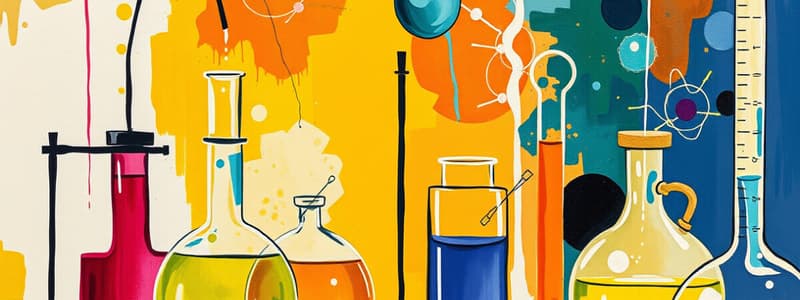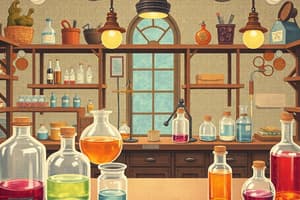Podcast
Questions and Answers
What pieces of apparatus or equipment are used for measuring temperature?
What pieces of apparatus or equipment are used for measuring temperature?
Thermometer
What pieces of apparatus or equipment are used for measuring small amounts of liquids?
What pieces of apparatus or equipment are used for measuring small amounts of liquids?
Pipette or dropper
What pieces of apparatus or equipment are used for measuring large amounts of liquids?
What pieces of apparatus or equipment are used for measuring large amounts of liquids?
Measuring cylinder
What apparatus is used for measuring the mass of a substance?
What apparatus is used for measuring the mass of a substance?
Why are most of the containers of substances and those used for heating made up of glass rather than metal?
Why are most of the containers of substances and those used for heating made up of glass rather than metal?
Explain why the thermometer should not be shaken vigorously to lower the reading to zero before using it.
Explain why the thermometer should not be shaken vigorously to lower the reading to zero before using it.
What is the importance of correctly identifying laboratory glassware and equipment?
What is the importance of correctly identifying laboratory glassware and equipment?
Flashcards are hidden until you start studying
Study Notes
Laboratory Apparatus and Equipment Overview
- Involves identifying and utilizing various laboratory equipment essential for chemical experiments.
- The laboratory is crucial for testing hypotheses and gaining empirical insights into chemical properties and reactions.
Classifications of Laboratory Apparatus
-
Measuring Type: Includes equipment for measuring quality, volume, temperature, and density. Common items are measuring glass, transfer pipette, measuring cylinder, and measuring cup.
-
Reaction Type: Used primarily for conducting chemical reactions. Typical apparatus includes test tubes, flasks, evaporating dishes, and crucibles.
-
Vessel Type: Designed for containing or storing solids, liquids, gases, and chemical reagents, with reagent bottles being a common example.
-
Separation Type: Essential for processes like filtration and evaporation. Includes funnels, separating funnels, beakers, crucibles, and condensers.
-
Solid Clamp Type: Employed for fixing and supporting various lab equipment, including iron clamps, rings, and support stands.
-
Heating Type: Used for applying heat to laboratory-grade materials. Includes apparatus such as test tubes, beakers, flasks, and evaporating dishes.
-
Matching Type: Facilitates the assembly and connection of apparatuses. Common items are glass tubes, valves, rubber tubes, and plugs.
Importance of Proper Lab Equipment Usage
- Proper handling ensures laboratory safety and minimizes the risk of accidents.
- Awareness of procedures and precautions is vital for effective laboratory work.
Key Activity Steps
- Research on common laboratory apparatus is required.
- Draw and document five examples from each classification, detailing their names, physical descriptions, and functions on designated activity sheets.
Essential Questions for Understanding
- Identification of specific apparatus for measuring temperature (thermometers), small and large liquid volumes (micropipettes and measuring cylinders), and mass (balances).
- Suggested proper storage and handling techniques for glassware to prevent accidents.
- Explanation of why glass is preferred over metal for containers and heating instruments, including factors like chemical resistance and thermal stability.
- Importance of correctly identifying lab equipment to ensure accurate experimentation and safety protocols.
Studying That Suits You
Use AI to generate personalized quizzes and flashcards to suit your learning preferences.



